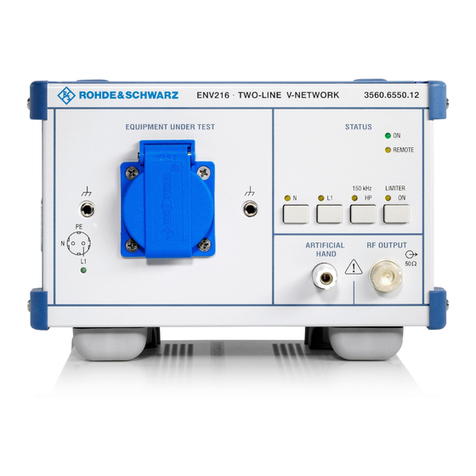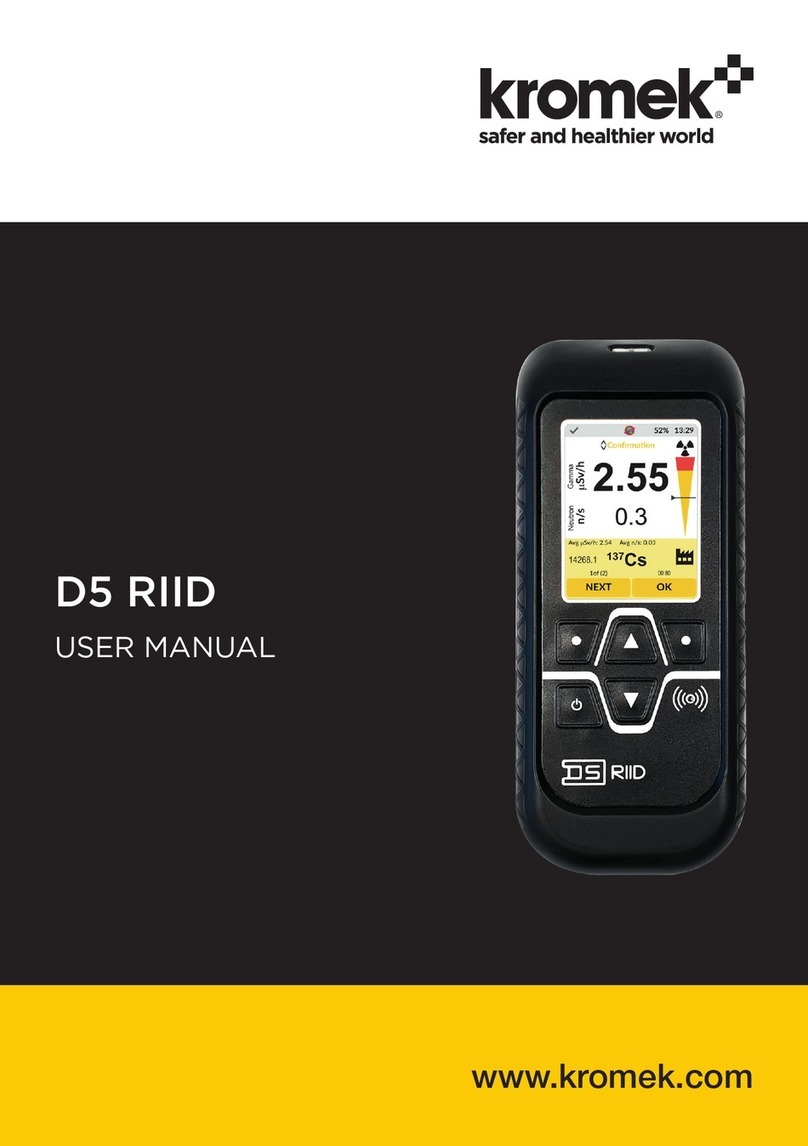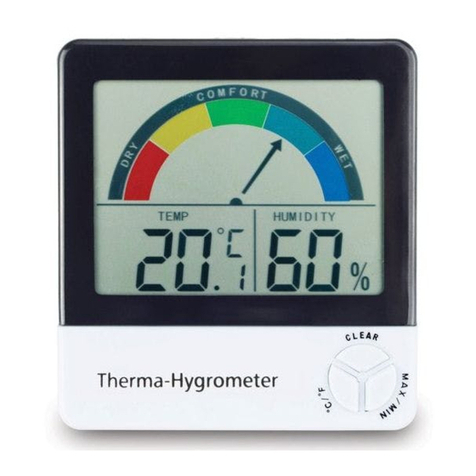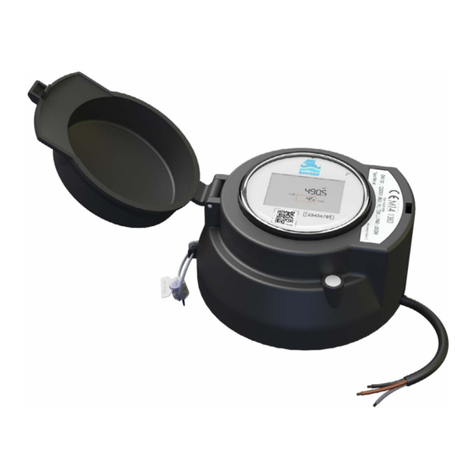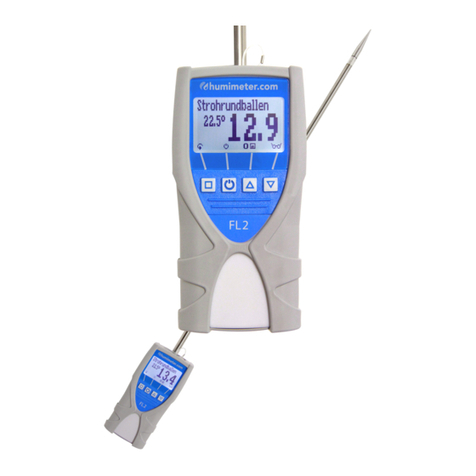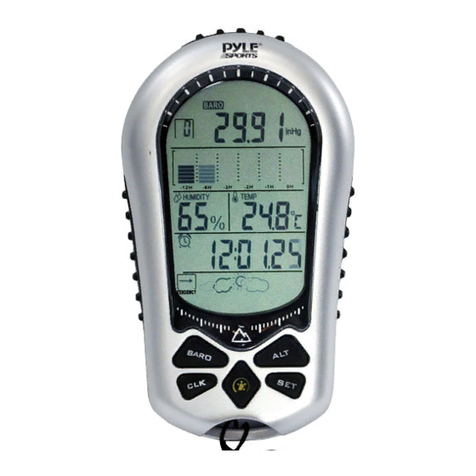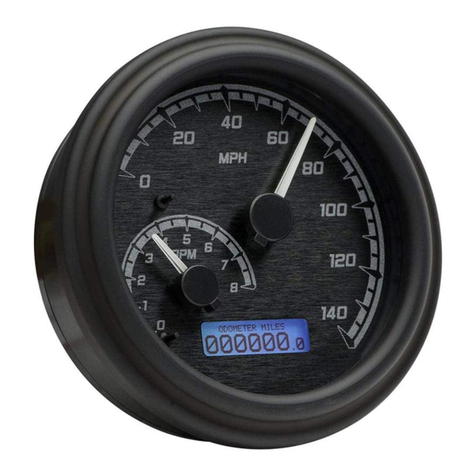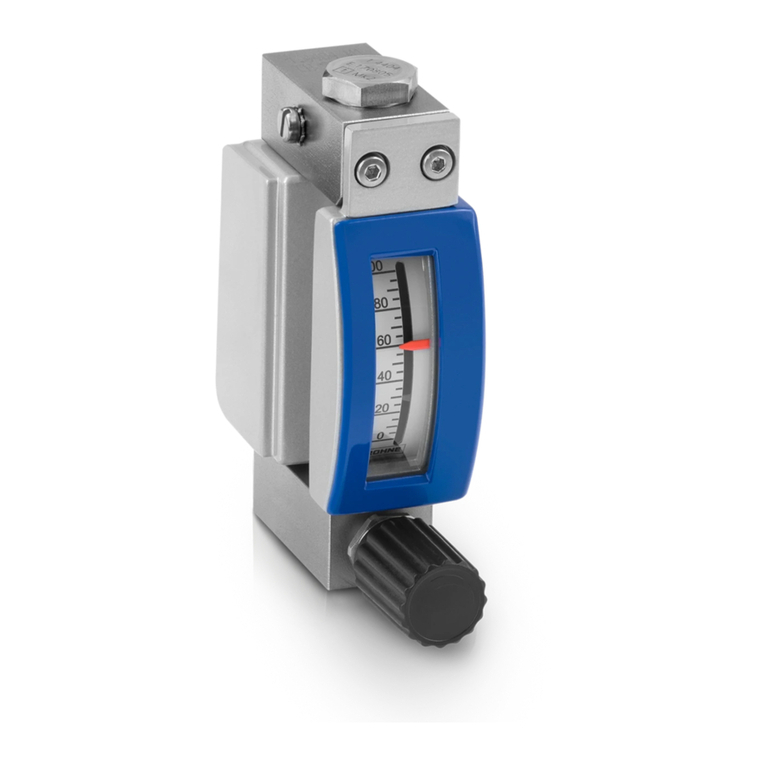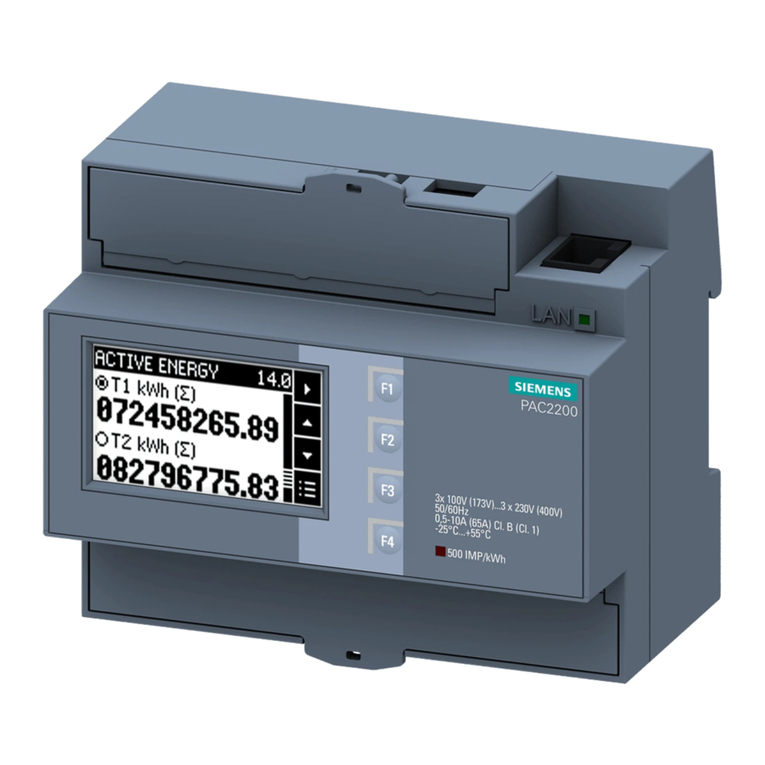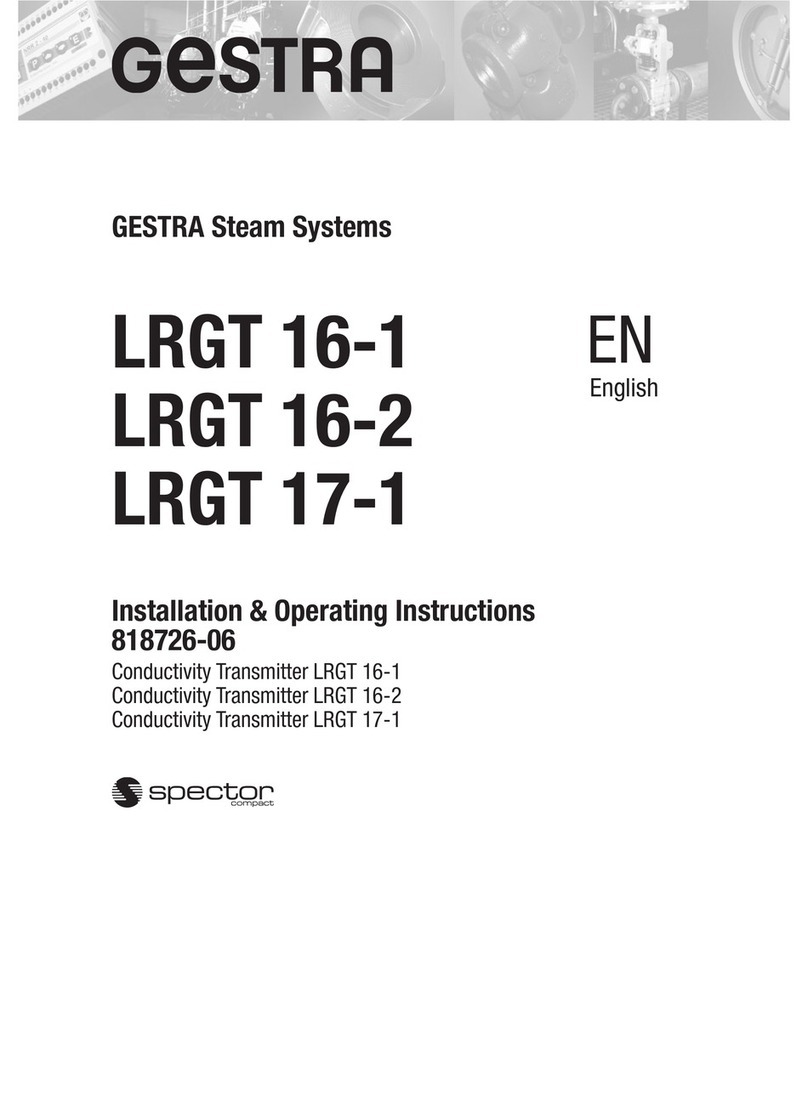Neutronics 7100E User manual

Instruction manual
Model 7100E
Trace oxygen analyzer/controller
Document Number: MN-A-0009
Revision Level: B
Part Number: C5-06-4900-14-0
Revision Date: August 10, 2016




Model 7100E Instruction Manual
Manual P/N: C5-06-4900-14-0
Revision A, dated 24-Jun-2016
3
1Contents
Welcome ....................................................................................................................................................... 5
Notice............................................................................................................................................................ 5
Safety instructions......................................................................................................................................... 6
Designated use ............................................................................................................................................. 6
Operational safety......................................................................................................................................... 6
2Introduction and overview..................................................................................................................... 7
2.1 General..........................................................................................................................................7
2.2 Features........................................................................................................................................7
2.3 System hardware overview...........................................................................................................9
Main board ............................................................................................................................9
Relay board...........................................................................................................................9
Power supply.........................................................................................................................9
Display board ........................................................................................................................9
Control panel.........................................................................................................................9
Sensor.................................................................................................................................10
Sensor flow-through head...................................................................................................10
Enclosure (chassis).............................................................................................................11
2.4 Analyzer inputs and outputs........................................................................................................13
Oxygen sensor input ...........................................................................................................13
Alarm-1 relay output............................................................................................................13
Alarm-2 relay output............................................................................................................13
Fault relay output.................................................................................................................13
Analog voltage output .........................................................................................................13
Analog current output..........................................................................................................14
Range ID output..................................................................................................................14
Service port.........................................................................................................................14
2.5 Control panel user interface........................................................................................................14
The “UP” pushbutton ...........................................................................................................14
The “DOWN” pushbutton ....................................................................................................14
The “MODE” pushbutton .....................................................................................................14
7-segment alphanumeric display ........................................................................................15
RUN indicator LED..............................................................................................................15
Alarm-1 indicator LED.........................................................................................................15
Alarm-2 indicator LED.........................................................................................................15
Fault indicator LED..............................................................................................................15

Instruction Manual Model 7100E
4
Revision A, dated 24-Jun-2016
Manual P/N: C5-06-4900-14-0
3System installation and start-up.......................................................................................................... 16
3.1 Installing the analyzer .................................................................................................................16
Step 1 –locate and mount the analyzer unit.......................................................................17
Step 2 –install the remote sensor........................................................................................18
Step 3 –install the analyzer.................................................................................................20
3.2 Starting up and Commissioning the System...............................................................................25
STEP 1 –Power Up the unit...............................................................................................25
STEP 2 –Calibrate the unit.................................................................................................26
STEP 3 –Set Alarm-1 and Alarm-2.....................................................................................26
4Analyzer operation ..............................................................................................................................27
4.1 System organization....................................................................................................................27
4.2 USER modes...............................................................................................................................28
CALIBRATE mode & calibration procedure........................................................................28
SET/VIEW ALARM-1 Mode ................................................................................................31
SET/VIEW ALARM-2 Mode ................................................................................................32
View active faults mode ......................................................................................................32
Return to RUN mode...........................................................................................................32
4.3 System modes.............................................................................................................................32
Self-test & warm-up mode...................................................................................................32
RUN mode...........................................................................................................................32
Alarm-1 Active mode...........................................................................................................33
Alarm-2 Active mode...........................................................................................................33
FAULT ACTIVE mode.........................................................................................................33
5Maintenance and troubleshooting.......................................................................................................34
5.1 System setup...............................................................................................................................34
System setup via control panel keypad...............................................................................34
System setup via service port.............................................................................................37
Change factory settings via hardware jumpers...................................................................48
5.2 Routine periodic maintenance.....................................................................................................49
5.3 Troubleshooting ..........................................................................................................................50
Fault codes..........................................................................................................................50
6Chapter 6 –Appendices......................................................................................................................52
6.1 Appendix A –Spare parts list......................................................................................................52
6.2 Appendix B –Specifications........................................................................................................53
6.3 APPENDIX C –Analyzer factory configuration settings .............................................................55
6.4 APPENDIX D –Control panel hot-key functions.........................................................................56
6.5 APPENDIX E –Range / Output chart.........................................................................................57
6.6 APPENDIX F –Zero calibration range settings..........................................................................57
7Limited warranty..................................................................................................................................58

Model 7100E Instruction Manual
Manual P/N: C5-06-4900-14-0
Revision A, dated 24-Jun-2016
5
Welcome
The Model 7100 analyzer is a compact microprocessor controlled instrument designed for oxygen
measurement. This manual provides detailed information on how to operate and maintain the 7100
analyzer from Neutronics.
For additional information regarding the maintenance and service of the Model 7100 analyzer, please
contact the technical support team at Neutronics. If you have questions or comments, we would like to
hear from you.
Neutronics Inc.
Gas Analysis Solutions
456 Creamery Way
Exton, PA 19341
Tel: +1-610-524-8800
Toll Free: 800-378-2287 (US only)
Fax: +1-610-524-8807
EMAIL: info@neutronicsinc.com
Equipment Serial Number: ________________
Notice
Product improvements and enhancements are continuous; therefore, the specifications and information
contained in this document are subject to change without notice.
Neutronics, Inc. shall not be liable for errors contained herein or for incidental or consequential damages
in connection with the furnishing, performance, or use of this manual.
No part of this document may be photocopied, reproduced, or translated to another language without the
prior written consent of Neutronics, Inc.
This work is protected under Title 17 of the US Code and is the sole property of Neutronics Inc. No part
of this document may be copied or otherwise reproduced, or stored in any electronic information retrieval
system, except as specifically permitted under US copyright law, without the prior written consent of
Neutronics Inc.
Copyright ©2016 Neutronics Inc.

Instruction Manual Model 7100E
6
Revision A, dated 24-Jun-2016
Manual P/N: C5-06-4900-14-0
Safety instructions
Installation, operation, and maintenance of the unit must be performed by trained technical personnel.
Technical personnel must be authorized to perform the tasks by the owner-operator.
Electrical connections must be established by an electrical technician.
To prevent personal injury, technical personnel must read, understand, and follow all warnings and
instructions in this manual before attempting installation or operation of the unit.
If the operator cannot read these instructions, operating instructions and safety precautions must be
read and discussed in the operator’s native language.
oSi el operador no puede leer las instrucciones, las instrucciones de operación y las
precauciones de seguridad deberán leerse y comentarse en el idioma nativo del operador.
oSi l’utilisateur ne peut lire les instructions, les instructions et les consignes de sécurité doivent
lui être expliquées dans sa langue maternelle.
No operator access is permitted inside the housing. Repairs not described in the Operating
Instructions may only be performed by the manufacturer or authorized service team.
Designated use
The analyzer is a microprocessor-based instrument for oxygen measurement in clean gas
applications. It is designed to minimize all effects of static discharges and interference from RFI and
EMI emissions.
If the equipment is used in a manner other than as described, the protection provided by the
equipment may be impaired and may pose a threat to the safety of personnel.
The manufacturer does not accept liability for damage caused by improper or non-designated use.
Operational safety
Please read this manual in its entirety before attempting installation or operation! Attempting to operate
the Model 7100E without fully understanding its features and functions may result in unsafe conditions
Always use protective eye wear and observe proper safety procedures when working with
pressurized gases.
Always assure the pressure of gas entering the Model 7100E is 1-3 psig.
Always calibrate the Model 7100E at an equivalent pressure and flow rate to the measured gas.
Always allow the Model 7100E to cool down before attempting to access the sensor.
Ensure the Model 7100E has been properly calibrated before use.
Never expose the Model 7100E analyzer chassis to water, high humidity or moisture. The analyzer
chassis is not watertight.
Never expose the Model 7100E to flame or high temperatures.
Never expose the Model 7100E analyzer to flammable gases or vapors. The unit is not rated
Explosion Proof, or Intrinsically Safe.
Never expose the Model 7100E directly to unregulated gas lines, cylinder gas. High gas pressures
may cause the oxygen sensor to rupture.
Ensure the analyzer unit is mounted in an area of free airflow to prevent the chassis from exceeding
the operating temperature specifications. Do not mount the analyzer against hot surfaces. Do not
block the ventilation louver on the analyzer chassis.

Model 7100E Introduction and overview
Manual P/N: C5-06-4900-14-0
Revision A, dated 24-Jun-2016
7
2 Introduction and overview
2.1 General
The Neutronics Model 7100E is a compact analyzer designed for trace oxygen gas measurement. This
microprocessor-based instrument offers an efficient solution in a small package for trace oxygen
measurement and process control applications.
The Model 7100E features a remote mounted, rapid-response mini-zirconia sensor with a measurement
range of 0 to 1000 ppm oxygen. Extremely fast response, high accuracy, and no requirement for periodic
calibrations make this analyzer a low-maintenance solution that delivers reliable performance for critical
process control applications.
The ZR-400E mini-zirconia sensor is mounted externally in a Stainless Steel housing assembly. This
allows for installation close to the sampling point for the fastest response time possible. The housing is
configured with either a threaded connection for installation in a flow-through head or with a KF adapter
fitting for KF flange mounting.
2.2 Features
The Compact Series analyzer modules are designed to be flush mounted to a panel or console. Because
of the small size of the Model 7100E analyzer, it can be integrated into a variety of equipment or control
panels. The remote sensor assembly is designed for mounting close to the sampling point to assure the
fastest response possible.
Other Features Include:
•Compact, rapid-response mini-zirconia oxygen sensor
•Two user-adjustable oxygen alarms with configurable relay outputs for process control use
•Two analog outputs: 4-20 mA and 0-1, 0-5, or 0-10 VDC
•Auto ranging or fixed range oxygen measurement (VDC output provided for auto-range
identification)
•Double redundant operating system, with automatic repair function
•Bi-directional RS-232 serial interface for connection to a PC, terminal, or printer

Introduction and overview Model 7100E
8
Revision A, dated 24-Jun-2016
Manual P/N: C5-06-4900-14-0
Chassis
Power SupplyBoard
RelayBoard
Main Board
Display
Board
Control
Panel
Fig.1, analyzer front and rear view
Fig. 2, basic internal analyzer components
Control
panel
Display
board

Model 7100E Introduction and overview
Manual P/N: C5-06-4900-14-0
Revision A, dated 24-Jun-2016
9
2.3 System hardware overview
Main board
The main board houses the microprocessor, and supporting electronics for controlling the operation of the
Model 7100E Analyzer. The main board receives the sensor input and provides the control and display
functions of the analyzer.
Relay board
The relay board houses relay contacts for all of the Alarm and Control features of the 7100E. The relays
are mapped discretely to each alarm to provide electrical outputs for reporting and process control use.
Power supply
The power supply board is designed to take 110/220 VAC, 50/60 Hz mains power input. The supply is
fused directly on the board. Optional 12 VDC and 24 VDC power supplies are available for installations
where a DC voltage is required to power the Model 7100E. A 12 VDC battery-backup power input
(battery not provided) is also provided to act as an emergency back up in case of mains power failure.
Display board
The display board is designed to generate a digital indication of the concentration of oxygen (Appendix E
–range / output chart), and fault codes (section 4.3.1). The display is a 7-segment, 0.75" alphanumeric
LED.
Control panel
The control panel serves as the main user interface. The Control Panel features the keypad (ramp-UP,
ramp-DOWN, and MODE keys) and the status LEDs. The control panel is designed to be splash and
water-resistant. There are #8-32 threaded mounting studs at each of the four corners for flush mounting
the unit to a control or equipment panel. The front control panel with neoprene gasket is suitable for
NEMA type 4 / IP66 environments when properly installed.

Introduction and overview Model 7100E
10
Revision A, dated 24-Jun-2016
Manual P/N: C5-06-4900-14-0
Sensor
The Neutronics ZR-400E mini-zirconia percent range oxygen sensor (Figure 3) is a cost effective solution
for many applications. It is a solid-state device based on a zirconia solid electrolyte sensor with a low
power, on-board heater, and two electrodes. Unlike many solid-state oxygen sensors, the ZR-400E does
not require a reference gas for normal operation.
The sensor is mounted directly onto a printed circuit board that supplies bias and heater voltages to the
sensor element. A small capillary on the sensor surface controls diffusion of oxygen into the sensor. At
operational temperature, oxygen is electrochemically reduced, causing current flow through the solid
electrolyte. Oxygen concentration in the sample gas is determined by measuring the current flowing
through the sensor’s two electrodes.
The robust design of the ZR-400E sensor assures accurate measurement as well as a quick response
characteristic to serve a wide range of oxygen measurement applications. Operating service life is 3-5
years under normal operating conditions, and it has an unlimited shelf life. It is not affected by position
and may be exposed to several G-forces with no ill effect on performance.
Sensor flow-through head
The optional sensor mounting-base (Figure 4) allows the Model ZR-400E sensor to be used for process
monitoring. It serves as both the receptacle for the sensor and the delivery system for a gas sample from
a process vessel or stream. It includes a sample inlet, a flow-through chamber, a sample exhaust, and a
threaded connection for the oxygen sensor.
2.3.7.1 Sample gas inlet
Gas must be directed from the measured process to the sample inlet port via positive pressure from the
source or from an external pump. The Model ZR-400E sensor and flow-through head combination is
suitable for installation in any Neutronics Inc. Process Sampling System.
Fig. 3, mini-zirconia oxygen sensor design

Model 7100E Introduction and overview
Manual P/N: C5-06-4900-14-0
Revision A, dated 24-Jun-2016
11
2.3.7.2 Sample gas exhaust
A sample gas exhaust port is provided for installation with a process oxygen sampling system. Gas must
be directed from the sample exhaust port to a suitable vent source that does not apply significant
backpressure on the sampling system. The unit can be installed in-line with any Neutronics Inc. process
sampling system.
Enclosure (chassis)
The chassis (Figure 5) is manufactured of specially coated stainless steel. It is designed to provide a
general level of protection against mechanical damage from the local environment. It is also an important
component of the electrostatic discharge (ESD) shielding design. Since the Model 7100E is a flush
mounted module, the portion of the instrument housed in the chassis will be located behind the control
panel or embedded within the customer equipment enclosure. The enclosure is general purpose (IP20)
and is not watertight.
Fig.4, sensor mounting base (flow-through head)
Fig.5, stainless steel enclosure (chassis)

Introduction and overview Model 7100E
12
Revision A, dated 24-Jun-2016
Manual P/N: C5-06-4900-14-0
RelayBoard
RS-232COMLine
Mains Power
Input
Power
Supply Main Board
Display
Board
Control
Panel
Line
Filter
Fault RelayOutputs
Alarm 1& 2RelayOutputs
RangeIDOutput
Analog VoltageOutput
4-20mAOutput
Remote
Sensor
Fig.6, analyzer configuration

Model 7100E Introduction and overview
Manual P/N: C5-06-4900-14-0
Revision A, dated 24-Jun-2016
13
2.4 Analyzer inputs and outputs
Oxygen sensor input
The oxygen sensor electrical input to the Model 7100E is used to indicate the oxygen concentration
measured by the Model ZR400E oxygen sensor. It is proportional to the oxygen present in the measured
gas at the sensor membrane. The oxygen sensor input port is a female 7-pin DIN connector to mate with
the supplied sensor interface cable connector.
Alarm-1 relay output
The Alarm-1 relay is mapped to the Alarm-1 setpoint, and is provided for process control use. The user
may set the oxygen level at which Alarm-1 activates (section 3.2.2). Alarm-1 may be configured as
ascending (highest oxygen level allowable) or descending (lowest oxygen level allowable) action. The
relay output may be configured for fail-safe (relay coil de-energized in alarm state) or non-fail-safe (relay
coil energized in alarm state) action. Factory default settings are ascending, and fail-safe (Appendix C,
Factory configuration). The Alarm-1 relay contacts are Form C (DPDT), voltage-free.
Alarm-2 relay output
The Alarm-2 relay is mapped to the Alarm-2 setpoint, and is provided for process control use. The user
may set the oxygen level at which Alarm-2 activates (section 3.2.3). Alarm-2 may be configured as
ascending (highest oxygen level allowable) or descending (lowest oxygen level allowable) action. The
relay output may be configured for fail-safe (relay coil de-energized in alarm state) or non-fail-safe (relay
coil energized in alarm state) action. Factory default settings are ascending, and fail-safe (Appendix C,
Factory configuration). The Alarm-2 relay contacts are Form C (DPDT), voltage-free.
Fault relay output
The fault relay output is used to indicate that there is at least one system fault active on the Model 7100E
analyzer (section 4.3.1 –fault codes and definitions). The relay output action is non-fail-safe, and is not
configurable. The fault relay contacts are Form B (SPST), voltage-free.
Analog voltage output
The analog voltage output is a dynamic potential used to indicate to a remote device the displayed
oxygen concentration during normal analyzer operation and system maintenance. The analog voltage
output follows the oxygen readout displayed on the 7-segment LED display during all system and user
modes except for user setup. For a complete listing of available output levels by analyzer range, refer to
Appendix E –range / output chart.
The analog voltage range can be adjusted by the user (section 4.1 –system setup). Available settings
are 0-VDC for minimum-scale-deflection, to 1, 5 or 10-VDC full-scale. The factory default setting is 0-1
VDC (Appendix C, Factory configuration). The analog voltage output is scaled according to the selected
range, and must be used in conjunction with the range ID voltage when the analyzer is configured for
auto-ranging (section 1.4.8).

Introduction and overview Model 7100E
14
Revision A, dated 24-Jun-2016
Manual P/N: C5-06-4900-14-0
Analog current output
The analog current output is a dynamic current flow used to indicate to a remote device the displayed
oxygen concentration during normal analyzer operation and system maintenance. The analog current
output follows the oxygen readout displayed on the 7-segment LED display during all system and user
modes except for user setup. For a complete listing of output levels by analyzer range, refer to Appendix
E –range/output chart.
The minimum scale deflection may be set to either 0 mA or 4 mA. Full-scale is fixed at 20 mA. The
analog current output is scaled according to the analyzer’s selected range, and must be used in
conjunction with the range ID voltage when the analyzer is configured for auto-ranging (section 1.4.8).
Range ID output
The Model 7100E can be configured by the user to automatically switch its measurement range, based on
the concentration of oxygen measured while in-service, to provide the most accurate, and highest
resolution outputs at all times. For a complete listing of analyzer ranges, refer to Appendix E –
range/output chart.
Remote auxiliary devices designed to interpret the Model 7100E analog outputs over multiple output
range scales require an indication of the analyzer’s selected range at all times for accurate scaling. The
Model 7100E features a 0-10 VDC Auto-Range Identification output. The range ID output is used in
conjunction with the analog voltage and analog current outputs when auto-ranging is used. It provides an
indication of the Analog outputs’ selected full-scale. There are four range ID voltage levels used in the
7100E to correspond with its four output ranges (Appendix E –range / output chart).
Service port
The service port provides a user-friendly means of digital communications with the Model 7100E
analyzer. Through this port, the unit may be configured, calibrated, and queried for most functions. The
RS-232 port may also be programmed to send out information on a timed basis for users who prefer to
use digital instead of analog interfacing with the analyzer. In addition, the service port may be used with a
PC based computer (such as a portable notebook computer) over a standard bi-directional RS-232 serial
interface.
2.5 Control panel user interface
The “UP” pushbutton
The “UP” pushbutton can be used to program the Model 7100E via the control panel. This momentary
push-button soft key is used to enter increasing values. Its function is menu-driven.
The “DOWN” pushbutton
The “DOWN” pushbutton can be used to program the Model 7100E via the control panel. This
momentary push-button soft key is used to enter decreasing values. Its function is menu-driven.
The “MODE” pushbutton
The “MODE” pushbutton can be used to program the Model 7100E via the control panel. This momentary
push-button soft key is used to navigate the operational modes available through the control panel. Its
function is menu-driven.

Model 7100E Introduction and overview
Manual P/N: C5-06-4900-14-0
Revision A, dated 24-Jun-2016
15
7-segment alphanumeric display
The 7-segment alphanumeric display feeds back information from the Model 7100E to the user via the
control panel. The primary purpose of the 7-Segment display is to show the oxygen concentration
readout. It is also used for feedback of operational status, fault codes, and other information necessary to
perform system setup and maintenance.
RUN indicator LED
The purpose of the RUN Indicator LED is to inform the user via the control panel that the Model 7100E is
measuring the concentration of the sample gas and updating the display and outputs accordingly, and
has not detected any alarm, or fault conditions.
Alarm-1 indicator LED
The purpose of the Alarm-1 Indicator LED is to inform the user via the control panel that the measured
oxygen concentration has exceeded the Alarm-1 threshold; Alarm-1 and its associated relay are in active
mode.
Alarm-2 indicator LED
The purpose of the Alarm-2 Indicator LED is to inform the user via the control panel that the measured
oxygen concentration has exceeded the Alarm-2 threshold; Alarm-2 and its associated relay are in active
mode.
Fault indicator LED
The purpose if the Fault Indicator LED is to inform the user via the control panel that at least one system
fault is active. Note that when the fault Indicator LED is active, the fault relay will also be active.

System installation and start-up Model 7100E
Manual P/N: C5-06-4900-14-0
Revision A, dated 24-Jun-2016
16
3 System installation and start-up
3.1 Installing the analyzer
Step 1
•Locate the
analyzer...
•panel
cutout
Step 2
•Install the
sensor...
•process
sampling
system
Step 3
•Install the
analyzer
Fig. 7, installation outline

Model 7100E System installation and start-up
Manual P/N: C5-06-4900-14-0
Revision A, dated 24-Jun-2016
17
Step 1 –locate and mount the analyzer unit
The Model 7100E is designed to be mounted flush to the surface of a stationary equipment control panel.
Select a suitable location for the analyzer unit where the digital display and status LEDs will be easy to
read, and the interface buttons on the display panel will be easy to access.
Cut and drill the mounting panel in accordance with the specifications shown in Figure 8. Clearance
holes for the #8-32 threaded mounting studs do not need to be tapped. Hex nuts are included to secure
the unit to a panel. Trim all burrs or sharp edges in the cutout or mounting-holes, which would interfere
with or damage the gasket on the analyzer control panel.
Slide the analyzer unit into the cutout, rear-chassis first, and seat the control panel gasket on the
mounting surface. The gasket on the analyzer control panel ensures a watertight seal around the control
panel cutout. Secure the threaded mounting studs with the supplied hex-nuts, and internal-tooth lock-
washers. The analyzer front control panel is suitable for NEMA Type 4, IP66 environments when properly
installed. The rear electronics chassis is suitable for NEMA Type 1, IP 20 environments.
The analyzer should not be exposed to water, adverse temperature, or shock. Ensure the analyzer unit is
mounted in an area of free airflow to prevent the chassis from exceeding the operating temperature
specifications. Do not mount the analyzer or sensor against hot surfaces. Do not block the ventilation
louver on the analyzer chassis.
2.91"
6.20"
6.62"
2.75"
PANEL CUTOUT & DRILL PATTERN
.169 DIA. HOLE
4 PLACES
Fig. 8, installation outline

System installation and start-up Model 7100E
18
Revision A, dated 24-Jun-2016
Manual P/N: C5-06-4900-14-0
Step 2 –install the remote sensor
The Model 7100E is supplied with one (1) Model ZR-400E oxygen sensor assembly (Figure 9), one (1)
sensor interface cable, and one (1) sensor flow-through head for connection to a sampled process gas
stream (if required). The Model 7100E can also be supplied with a Neutronics Inc. process Sampling
system, built-to-application. For detailed instructions on remote sensor installation with a Neutronics Inc.
Process Sampling System, please refer to the appropriate equipment manual.
3.1.2.1 Flow-through head
Surface-mount the flow-through head horizontally (as shown in Figure 10) or vertically on a stationary
panel. The sensor flow-through head is 1.25" diameter stainless steel, and is machined to accommodate
two #6-32 machine-type mounting screws (1-inch on center). Be careful not to over tighten the mounting
screws. Allow sufficient space to screw the Model ZR-400E oxygen sensor into the top threaded port of
the flow through head, and for the sample lines and sample inlet and exhaust fittings.
SENSORRECEPTACLE
O-RINGTOPSEAL
1/8" FNPT-
SAMPLE
EXHAUST
GASKET
MOUNTINGSCREW
INSERT- #6-32
1/8" FNPT-
SAMPLEINLET
THREADEDCONNECTOR- 3/4-16
SENSOR
MOUNTINGHOLES,2
PLACES,#6-32THREAD
#36(.106) DIA.
7-PINPLUG,DIN
Fig. 10, sensor installation detail (threaded connector configuration
with flow-through head)
Fig. 9, sensor assembly (shown with KF fitting and short
tongue/diverter vane configuration)
Table of contents
Other Neutronics Measuring Instrument manuals
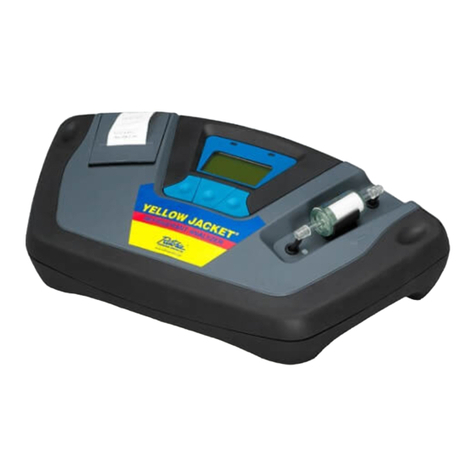
Neutronics
Neutronics YELLOW JACKET 68945 User manual
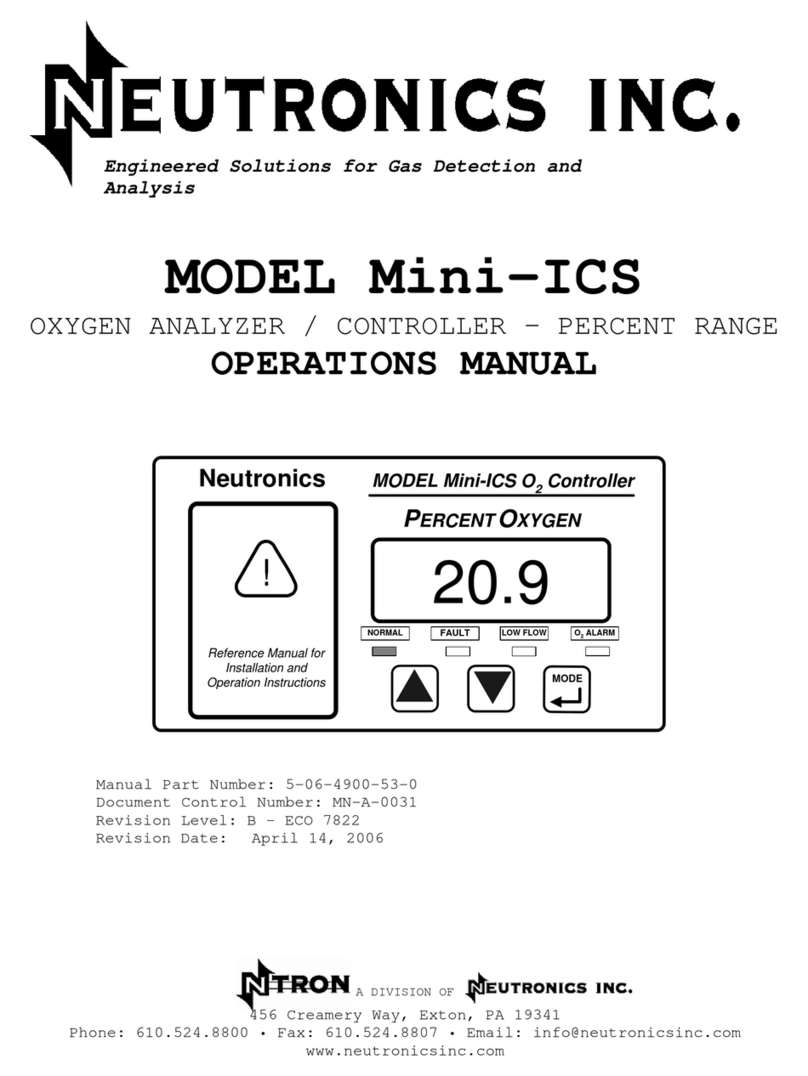
Neutronics
Neutronics NTRON Mini-ICS User manual
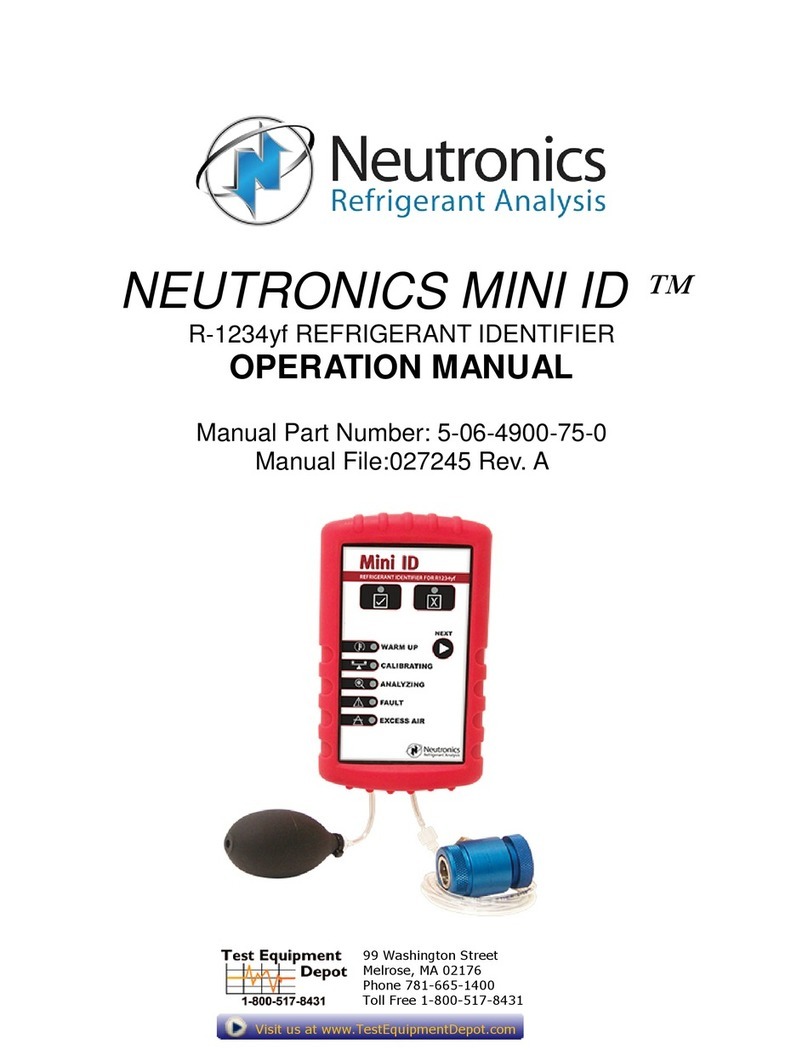
Neutronics
Neutronics MINI ID User manual

Neutronics
Neutronics ULTIMA ID User manual
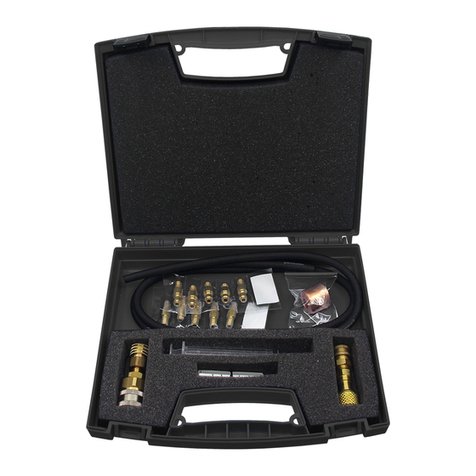
Neutronics
Neutronics QUICK DETECT User manual

Neutronics
Neutronics UltimaID User manual

Neutronics
Neutronics ULTIMA ID PRO RI-700H User manual
